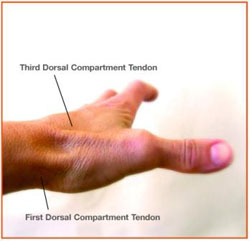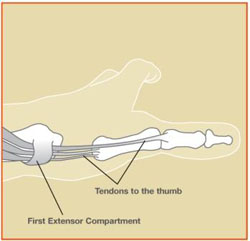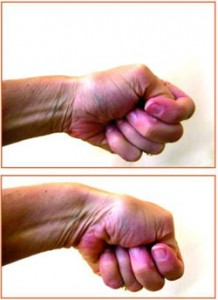 What is it?
What is it?
DeQuervain’s syndrome results in painful tendons on the inside of the wrist, closest to the thumb. Tendons are the rope-like structures you see on the back of your hand when straightening your fingers, which are what pull the bone. In patients with this syndrome, the tunnel, where the tendons run, narrows. This causes the tunnel’s soft tissue to begin to thicken.
What are the symptoms?
Patients with DeQuervain’s syndrome most often experience pain when moving the hand and thumb in actions like twisting or strong grasping. People often complain of a feeling of inflammation.
 What causes it?
What causes it?
Although there was an old theory that DeQuervain’s syndrome was an effect of wringing out cloth diapers, doctors aren’t sure what the causes are. It can develop in patients of all ages, but is seen most often in new mothers 4 to 6 weeks after birth. Newer theories point to changes in hormones and swelling due to holding the baby.
How do we diagnose it?
Doctors may use Finkelstein’s test to get a diagnosis. This involves grasping and turning the thumb and forefinger, which, if a patient has DeQuervain’s syndrome, will usually cause a sharp pain in the forearm.

How is it treated?
Simple solutions like a splint that inhibits thumb and wrist movement, or over-the-counter pain medications can help. There are, however, alternative options which attempt to reverse the disease’s course. These include cortisone-like steroid injections and surgery. Though the injections have helped many patients, response varies and does not work for all patients.


